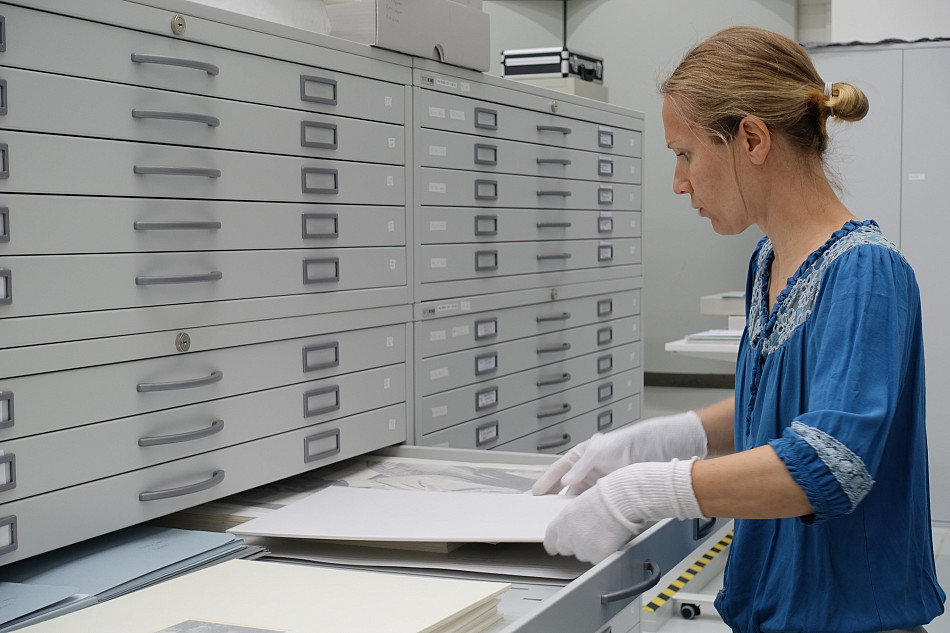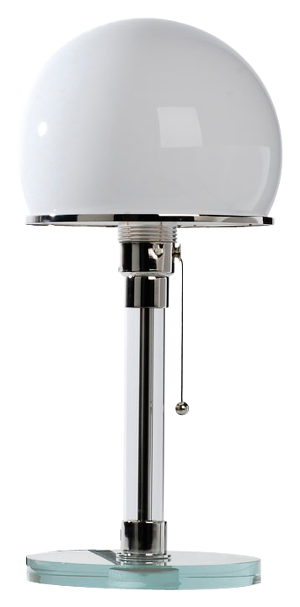
Wencke Clausnitzer-Paschold
Archivist
Wencke, you've been an archivist at the Bauhaus-Archiv for ten years now. Tell us a bit about your daily work!
At the moment we are closed due to the construction work for our new building, otherwise I would still spend my mornings with the users – providing archival materials, answering research questions in the reading room. In the afternoons I used to record new acquisitions and donations. I am also in frequent contact with researchers and of course with my colleagues, for example when it comes to restoration and preparing exhibitions. But now that the archive and the museum are closed, there is finally time to take care of the collections in a more comprehensive way.
What does that entail?
As a museum and archive, we collect objects on the one hand and archive documents on the other. Our holdings are arranged according to persons – they include manuscripts, life documents such as passports, certificates, deeds, correspondence and also collections from or about an estate. All this must be put into an archival order when it first comes to us. For example, when we receive the estate of a person, every object and document is given an inventory number and recorded in our databases. An inventory is drawn up, often also an analogous finding aid. In the public database Kalliope you can also search our documents online. The digitisation of our holdings is a chapter of its own.
Sounds like tons of material and very painstaking work. Which kind of estates are of interest to us – and do we really collect every last bit?
What interests us most, of course, are bequests and estates of Bauhäuslers, i.e. people who studied or taught at the Bauhaus. We collect the documents from their time at the Bauhaus, but also afterwards, in order to get as comprehensive a picture of a person as possible and to be able to reconstruct biographies. The Bauhaus has had great influence, not only in the history of design and architecture, but also in the lives of those who were at the Bauhaus. And it did not exist in a vacuum. That's why we're also interested in people who neither taught nor studied at the Bauhaus, but who were in contact with it, for example through correspondence with Bauhäuslers, or through other networks such as the Werkbund. So we are interested in quite a lot!
Now, that's quite something. Can you give us a ballpark figure?
In fact, it is so much that we measure the documents in metres. We hold about 495 shelf metres of archival material, which corresponds to about 666,570 sheets. In the old building on Klingelhöferstraße there was simply no space left for all our archive material. The new building is therefore urgently needed not only for the museum but also for the archive. Also the reading room needs to be bigger. Space is always a rare commodity in an archive!
Many people still associate archives with piles of dusty files and narrow corridors. Is that the reality?
No, thank God! For conservation reasons alone, this would not be possible. We have bright and spacious rooms to work in and, very importantly, dust-free storage rooms, in which the climate is just right for each type of material. Also, I only spend one part of my time in the depot. Before anything is ready to go into the archive, it first passes through my hands. Let's say a letter: I have to find out how many sheets it consists of, in what condition it is, I determine the dimensions and the material technique - whether manuscript or typescript – and record the date, as well as the addressee and sender, of course. Then it is recorded in the directory and only as the last step it is stored in the archive. The location can then be looked up through the finding aids.
You're on intimate terms with our archives. Do you have a favourite object?
I am often asked this question – but I honestly have to say that no, I don't have a favourite object. There are so many different, extraordinary pieces in our collection that I can't decide on any one exclusively. It is quite exciting, though, to hold a letter from Albert Einstein to Walter Gropius in your hands, for example. Or to see how Lyonel Feininger adorned his letters with drawings.
One last personal question: Are archivists obsessively tidy? Do you also keep things very orderly at home?
Good question! I am very neat. That's probably just part of the job. Finding things without spending tons of time looking for them – that's what it's all about, I guess. Yes, my home is pretty neat and tidy too!
